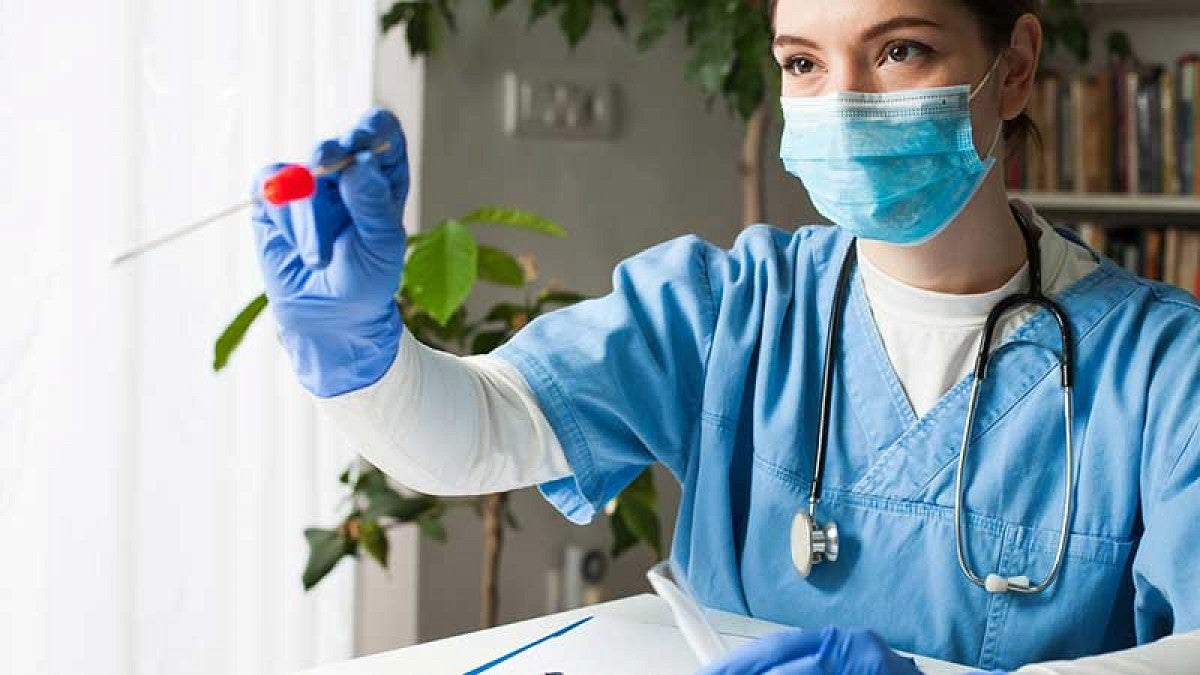The University of Oregon is leveraging the strength of its research capabilities to launch an expansive COVID-19 testing initiative that will help the university, Lane County and the state get back to business safely, including a return to on-campus instruction in October.
The ambitious new program, which aims to provide for thousands of COVID-19 tests per week, is made possible by an $800,000 contribution from PacificSource Health Plans to the UO’s COVID-19 Monitoring and Assessment Program, which combines the UO’s strengths in genomics, prevention science and data science with on-the-ground testing. The program has been in development this spring, and thanks to the gift will help the university meet the testing benchmarks necessary to offer in-person learning in the fall and stay open.
“This is an important initiative and a huge step forward for the university, Lane County and the region,” said UO President Michael H. Schill. “This leverages our skills and resources in data science to accelerate our planned resumption for the fall.”
The testing program began this spring, with successful first efforts using student volunteers.
It will begin testing staff volunteers this summer. The team has refined data collection methods and certified a campus lab for collecting and processing human samples.
Over the summer months, the university will partner with Lane County to increase testing capacity from dozens of tests per week to thousands, expanding the program to include testing for UO faculty and staff members who choose to participate and possibly other community members.
The results from those tests will flow into a secure database, which may be used by public health officials to conduct contact tracing on any positive results. UO researchers also are applying for emergency U.S. Food and Drug Administration authorization to use a cheaper, faster and easier testing method that uses saliva instead of the more labor- and cost-intensive nasal swab collection.
“Our top priority is the safety and health of our community,” Schill said. “This initiative will inform our planning for the upcoming academic year. Because of our resources as a Tier 1 national public research university, and thanks to partners like PacificSource, the UO is well positioned to be a leader in the recovery process, in coordination with government agencies.”
“We are pleased to support this critical initiative and work in collaboration with the UO and Lane County Public Health to help safeguard the community,” said Ken Provencher, president and CEO of PacificSource. “This work, and additional collaborative efforts across the state of Oregon, serve as an important initial commitment to being part of the solution in addressing this health crisis.”
Schill said this is the first time the UO has led a comprehensive medical testing project related to a pandemic.
“COVID-19 has presented new challenges for everyone,” he said. “However, innovation and collaboration are not new to us. This project leverages areas of excellence where we are truly world class.”
Beyond the basics of safely opening up campus, the COVID-19 monitoring and assessment team is working on novel solutions that will benefit the entire state. The discoveries they’re making in collaboration with other institutions around the country could have a global reach.
That effort is advancing due in large part to the capabilities of the UO’s genomics core facility, which can process thousands of samples per week at relatively low cost, a necessity for the next generation of COVID-19 testing methods.
“Fast, inexpensive and easy testing will improve the success of testing efforts,” said Leslie Leve, professor in prevention science and associate vice president for research. “This will enable us to quickly and easily test symptomatic individuals, as well as those who may not be feeling ill but who have come in contact with someone who tested positive.”
“This testing capacity will help our community stay ahead of the spread,” Leve said.
Widespread testing will also generate mountains of data. By leveraging the university’s strengths in big data, the team will distill this information to help leaders make prudent decisions.
“That steady stream of information will run straight to UO experts in databasing, computer science and other areas,” said Bill Cresko, professor of biology and executive director of the Presidential Initiative in Data Science. “Many of those experts are part of the data science initiative, and this collaboration between different disciplines is where we will have the most impact.”
By effectively analyzing large volumes of data, from different sources and stored in compliance with privacy laws, researchers will create models that show the prevalence of COVID-19 and how the virus is most likely to spread. This will enable them to forecast the effects of potential interventions that the university and the county might consider.
How can hot spots inform forecast models? What will be the likely outcome if most people or just some people wear masks and practice social distancing? What are the most probable scenarios that would result from large gatherings? Answering those questions, and many others that come up, will require constant adjustments and updates based on the incoming data that the project and other regional and national testing efforts will generate.
Additional funding and cash contributions will be needed to grow capacity, said Mike Andreasen, vice president for university advancement.
“We are deeply grateful to have PacificSource as a partner in this work,” he said. “We will look to our community for support to help us continue to grow capacity, develop more efficient and economical testing and support efforts to resume aspects of normal life.
“This is an investment with tangible, immediate benefits. A quarantine will stop the spread of COVID-19, but it also stops the local economy. More nuanced policy decisions require data and expert analysis. UO researchers won’t be making those decisions, but they will be informing those who do.”
—By Ed Dorsch, University Communications


